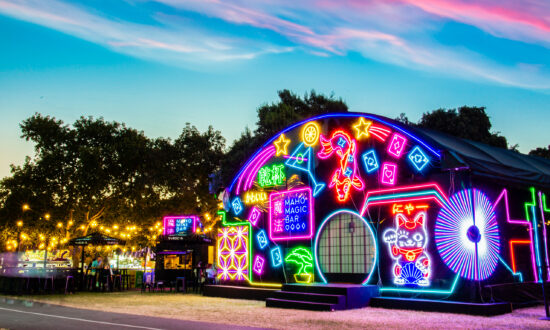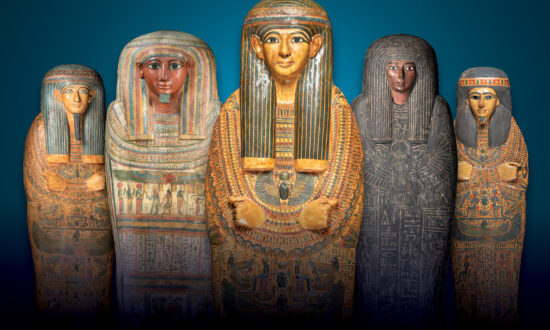“We don’t have visitors often,” Bernadette Klavins says of Switchboard Studio, a cream-coloured, corrugated iron shed in Norwood that she shares with a dozen other sculptors and painters. “So often, people don’t know it exists”.
Klavins’ corner of the long-running space, which she’s rented for the past three years, houses a cross-section of her recent work. A set of ochre-red bricks are laid out flat on a trestle, miscellaneous chunks of rubble, stone and wood appear in random corners, and on the floor sits an otherworldly black shape with the curves of a topographical map and a velvety, charcoal surface.

Photo: Jack Fenby / InReview
“I guess a lot of my work is looking at the human relationship to ideas of deep time, and climate, and geological shifts,” she says. “And trying to relate to that on a really local, human-scale level.”
The black pit comes from Vast spoils, a body of work exhibited at FELTspace earlier in the year that drew inspiration from quarries and open-cut mine pits gouged out of the natural landscape.
“There’s this trail of wounds left in the earth across Australia,” Klavins says. “From single-person mining sites – someone digging a hole – to big mining corporation sites.”
After spotting a series of quarries on a flight to Perth pre-pandemic, she spent the subsequent lockdowns trawling Google Earth for inspiration.
“The aerial view of those sites is really compelling. They’re so beautiful and sublime, but it’s a complex thing; these colour shifts, the gradation of those places, they’re really interesting sites.”
The sculptures Klavins created for Vast spoils became “little analogues” for what happens at those sites. “There’s sump oil and black sand in the work, and cast objects. Trying to create these environments that had that feeling of the micro and the macro about them.”

Bernadette Klavins is surrounded by a cross-section of her recent work at Switchboard Studios. Photo: Jack Fenby / InReview
Here in the studio, Klavins was continuously reminded of how even her art practice is tied into the supply chains and industrial complexes that hinge on digging up the earth. “I was using a lot of pewter, which is a really low-melt metal, just using a camp stove in my studio and melting it down. During the process of the show, pewter tripled in price.”
Her latest show at Post Office Projects gallery in Port Adelaide, Recollecting ruins, explores the tensions between humanity and geology from another angle, by enlisting friends and followers to collect discarded bits of rubble, tiles, concrete and brick from around their neighbourhoods.
‘I collected all these pieces and then used a core drill to take core samples of each item,” she explains.
She describes the result as a kind of “archive”, a simulacrum of how our present moment might appear in the layers of strata that bear witness to the earth’s long history. “A portrait of the landscape today, and then looking forward at these things that are left behind, and the materiality of our time.”

Photo: Jack Fenby / InReview
Recollecting ruins, which runs until December 17, also includes photographs of the drilling process, as Klavins’ sculptures began to echo the industrial processes – and their by-products – that she was interrogating.
“Water runs through the machine to help the drill cut through masonry, and as you cut through the rock, a bit of a slurry of material forms. So at the end of each day I would take an aerial shot of the driveway to get a sense of all of these aggregates becoming one new form.”
Klavins’ fixation on earthen materials is personal; those bricks on the table are connected to a 2018 exhibition, Unearthed, which explored the impact of humans as geologic agents, incrementally shifting and shaping the world around them in ways that have an seismic cumulative effect. It reminded her of her paternal grandfather, a Latvian migrant who worked in a quarry for many years.
“He would ferry clay from the quarry to the brickyards,” she says. “He also hand-selected every brick in the home they built; it was this idea of his role in moving material from one place to another, how much he did in his lifetime, and the brick symbolising that unit, the individual.”

Photo: Jack Fenby / InReview
When her grandfather died, and her grandmother was about to sell the house, Klavins salvaged a handful of leftover bricks that had sat in the backyard for half a century. She then cast her own replicas, made from clay she dug up at Ironbank, before arranging them into small, undulating sculptures that mimic the way paved surfaces shift and buckle as the natural movements of earth and tree roots reassert themselves over a human sense of order.
“Those little moments of being a pedestrian in a suburb, all those little slippages, those little signs of geologic movement on a really local scale,” she explains. “A pothole forming, [which means] ‘Oh, there’s something happening underground’.”
Recently, Klavins has been exploring blacksmithing, a trade practised by her maternal grandfather. Like her other grandfather’s old bricks, it gives the work she does at Switchboard another layer of personal meaning that hints at a time-scale bigger than any one human life.
“It was a really helpful starting point for me, thinking about those kinds of ideas that are quite hard to tackle,” she reflects. “To try and do that in a way that’s poetic, instead of being really didactic with it.”

Photo: Jack Fenby / InReview
Read more about Bernadette Klavins’ art practice on her website.
In the Studio is a regular series presented by InReview in partnership with not-for-profit organisation Guildhouse. The series shares interesting stories about South Australian visual artists, craftspeople and designers, offering insight into their artistic practices and a behind-the-scenes look at their studios or work spaces. Read our previous stories here.
Support local arts journalism
Your support will help us continue the important work of InReview in publishing free professional journalism that celebrates, interrogates and amplifies arts and culture in South Australia.
Donate Here




